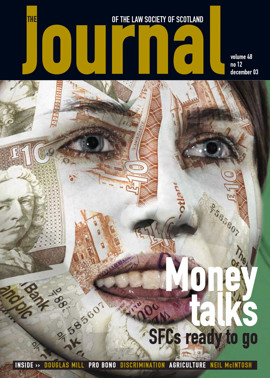SDLT: registration requirements
The 1 December 2003 saw the advent of Stamp Duty Land Tax (SDLT). With effect from that date, subject to the transitional provisions outlined below, stamp duty was abolished except in relation to share transactions and certain transactions relating to partnerships. The registration requirements of SDLT are very different. This article advises on the procedures solicitors must follow to ensure that applications for recording or registration in the Land Register of Scotland, the General Register of Sasines and the Books of Council and Session comply with the requirements in the Finance Act 2003.
How does SDLT affect transactions?
Unlike stamp duty, which is a voluntary tax on deeds, SDLT is a self-assessed compulsory tax on chargeable land transactions backed up by a wide range of compliance powers. For the purposes of the SDLT regime land transactions fall into three categories:
Those requiring completion of a land transaction return. The return must be submitted to the Inland Revenue, who will provide a Revenue certificate, the original of which must accompany the application for registration or recording to which the land transaction relates.
Those which do not require the purchaser to submit a land transaction return to the Inland Revenue but which nonetheless require the purchaser to complete a self-certificate form certifying the reason no land transaction return is required.
Those that are exempt from SDLT or fall outwith the definition of land transactions in terms of the Act.
Section 77 and schedule 3 set out the rules for determining whether a land transaction requires to be notified to the Inland Revenue or whether it is capable of self-certification. Section 48(2) lists those land transactions that are exempt from SDLT.
Registration requirements
Section 79(1) places a duty on the Keeper not to register, record or otherwise reflect any document effecting or evidencing a land transaction, falling within either category 1 or 2 above, in any of the Registers maintained by him unless a certificate as to compliance with the Act accompanies the application. The Keeper will therefore reject any application in respect of a land transaction falling within categories 1 and 2 above, which is not accompanied by an Inland Revenue certificate or self-certificate as appropriate. The certificate will be returned once the registration or recording process is complete.
Land transactions falling within category 3 require neither an Inland Revenue certificate nor a self-certificate. These include any security interest (standard security, discharge etc) or a licence to use or occupy land. In addition the Inland Revenue has advised that saving notices introduced by the Title Conditions (Scotland) Act 2003 will require neither notification by way of a land transaction return nor self-certification. The one exception to this is a section 19 agreement to re-allot a real burden. A section 19 agreement will require to be accompanied by a self-certificate or, if consideration of £60,000 or more passes, an Inland Revenue certificate.
Transitional provisions
Schedule 19 details the circumstances in which deeds remain liable to stamp duty on or after 1 December 2003. In general, a transaction will not be subject to SDLT unless its effective date, generally the date of completion of the contract, is on or after that date. Section 121 provides that completion in Scotland means, in the case of a lease, when it is signed by the parties or constituted by any other means, or in relation to any other transaction the settlement of that transaction. Special provisions apply where the transaction is effected in pursuance of a contract concluded before 10 July 2003, or a contract entered into and substantially performed before 1 December 2003 but after 10 July 2003. If you are in any doubt as to whether a land transaction is liable for SDLT or stamp duty you should contact the Inland Revenue for advice.
Situations may arise after 1 December where a deed, which on the face of it appears to be subject to SDLT, is in fact subject to stamp duty because of one of the transitional provisions. In that circumstance a covering note should accompany the deed explaining why the deed is not subject to SDLT. A covering note should be submitted in the following circumstances: where the deed is subject to stamp duty but on the face of the deed the effective date of the transaction is on or after 1 December 2003; and the deed itself has not been examined by the Inland Revenue (i.e. the deed contains a Finance Act clause or reference to the Stamp Duty (Exempt Instruments) Regulations 1987).
Advice and guidance
General advice on SDLT can be obtained from the Stamp Taxes Enquiry Line on 0845 603 0135, open 8.30 am to 5.00 pm Monday to Friday, except Bank Holidays. Copies of the land transaction return and supplementary sheets can be obtained from the Stamp Taxes orderline on 0845 3021472. The Inland Revenue does not accept photocopies as the forms contain a unique certificate number. Their website www.inlandrevenue.gov.uk/so also offers assistance. The Keeper has issued a Registers Update No 11 about SDLT, which includes checklists on land transactions and the submission of certificates – see www.ros.gov.uk/updates. Advice on the registration requirements can be obtained from either of the Keeper’s Customer Service Centres in Edinburgh or Glasgow (for contact details see www.ros.gov.uk).
In this issue
- Staying awake, actually
- Keep sane, if not sober
- Obituary – Sheriff Frank Middleton
- Money matters
- Clear and present danger
- For love or money
- Setting off abroad
- Legacy giving
- Marking out the pitch
- A merry spam-free Christmas
- Opening up the bench
- Victims find a voice
- Round the houses
- Allowing sexual questioning
- Scottish Solicitors’ Discipline Tribunal
- Discrimination: widening the net
- New rights for farm tenants
- Protection sans frontieres
- Football’s financial red card
- Website reviews
- Book reviews
- Asbestos safety
- Housing Improvement Task Force
- SDLT: registration requirements






